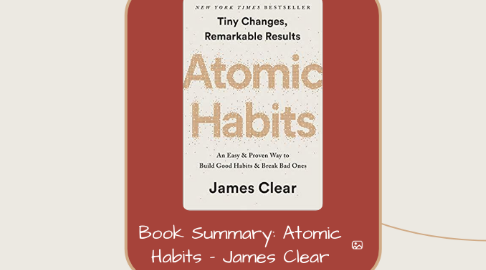
1. HOW TO FORM GOOD HABITS
1.1. Certain stimuli can trigger habitual behavior.
1.1.1. Once you understand that, you can use this knowledge to change your habits.
1.2. Encourage better habits by changing your environment.
1.2.1. Make your cues as obvious as possible, and you'll be more likely to respond to them!
1.2.2. Example: Want to eat healthier snacks? Leave them out on the counter, rather than hiding them in the salad drawer
1.3. Use implementation intentions.
1.3.1. Don't make vague statements such as "I will eat better".
1.3.2. Instead, create a clear plan of action, and set out when and where you will carry out the habit you want to cultivate.
1.4. Build temptation
1.4.1. Humans are motivated by the ANTICIPATION of reward
1.4.1.1. Our brain not only releases dopamine (the feel-good hormone) when we do pleasurable things, but also when we anticipate them
1.4.1.2. Making habits attractive will help you stick to them.
1.4.2. Link the habit you want to form (but are not enjoying) with a behavior that you're drawn to
1.4.3. Example: Allow yourself to watch episodes of your favorite show while you're cycling at the gym.
1.5. Make the habit as easy to adopt as possible
1.5.1. Reduce friction for good habits, increase friction for bad habits
1.6. Use the 2-minute rule
1.6.1. Make any new activity feel manageable by only committing to 2-minutes of it
1.6.2. This is a way to build easily achievable habits, and those can lead you on to greater things
1.6.3. Simply getting started is the most important step!
1.7. Make your habits immediately satisfying
1.7.1. When you're pursuing habits with a delayed return, try to attach an immediate gratification to them
2. How To Build Awesome Habits: James Clear | Rich Roll Podcast
3. HOW TO KEEP YOUR HABITS ON TRACK
3.1. Option 1: HABIT TRACKER
3.1.1. Example: Use a calendar or diary to create a habit tracker > cross off every day that you manage to stick to your good habit
3.1.2. Habit tracking itself is an attractive, satisfying habit, which is why it is so effective
3.2. Option 2: Contract
3.2.1. Develop a habit contract that imposes negative consequences if you fail to stay on track
3.2.2. Involve other people > simply knowing that someone is watching you can be a powerful incentive to keep going
4. ABOUT THIS BOOK
4.1. Title
4.1.1. Tiny Changes, Remarkable Results
4.1.2. Atomic Habits
4.1.3. An Easy & Proven Way to Build Good Habits & Break Bad Ones
4.2. Published
4.2.1. 2018, by Avery
4.2.2. New York Times Bestseller
4.3. Author
4.3.1. James Clear
4.3.1.1. American author, entrepreneur, and photographer
4.3.1.2. Website
4.3.1.3. Also visit: The Habits Academy
4.3.2. The Surprising Power of Small Habits by James Clear
4.4. Get the book on Amazon
5. WHAT ARE HABITS?
5.1. Behaviors that we perform automatically, with little or no thought
5.2. Habits are powerful
5.2.1. If repeated daily, even the smallest actions can have a huge effect
5.3. Positive change requires patience
5.3.1. But you can be confident that good habits are keeping you on the right trajectory, even if you don't see immediate results
5.4. Making big changes in your life doesn't require major upheaval - often, tiny changes to your behavior are enough to lead to the desired results.
6. HOW ARE HABITS FORMED?
6.1. Behaviors that result in satisfying consequences tend to get repeated until they become automatic.
6.2. TRIGGER > CRAVING > ACTION > REWARD
6.2.1. Habits start with a cue / trigger, followed by a craving for a change of state
6.2.2. This is followed by our response / action, and finally the reward
6.3. Example: Morning coffee
6.3.1. Cue = waking up
6.3.2. Craving = feeling alert
6.3.3. Action = drinking coffee
6.3.4. Reward = feeling alert

